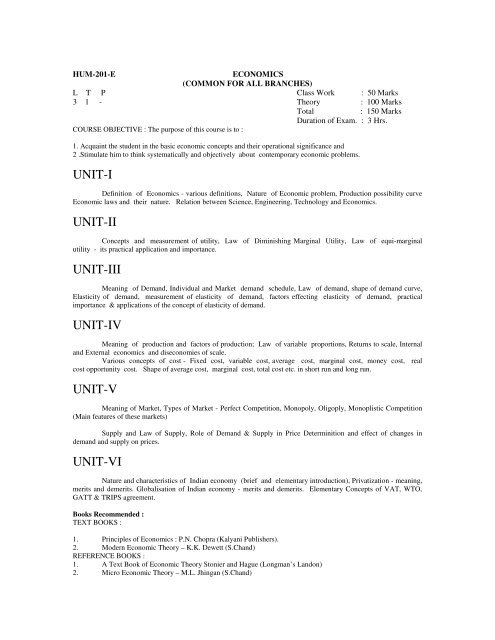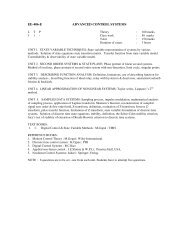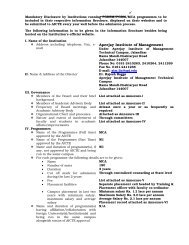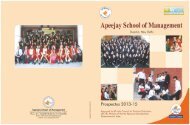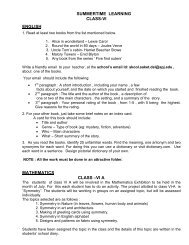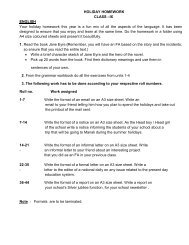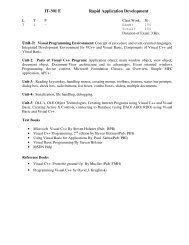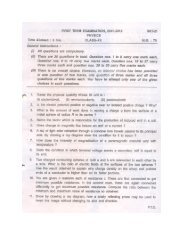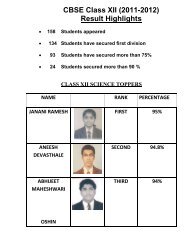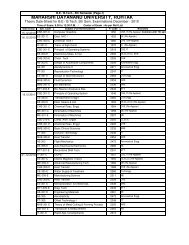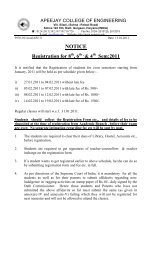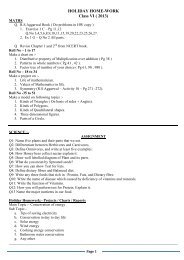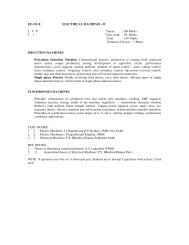UNIT-I UNIT-II UNIT-III UNIT-IV UNIT-V UNIT-VI
UNIT-I UNIT-II UNIT-III UNIT-IV UNIT-V UNIT-VI
UNIT-I UNIT-II UNIT-III UNIT-IV UNIT-V UNIT-VI
You also want an ePaper? Increase the reach of your titles
YUMPU automatically turns print PDFs into web optimized ePapers that Google loves.
HUM-201-E<br />
ECONOMICS<br />
(COMMON FOR ALL BRANCHES)<br />
L T P Class Work : 50 Marks<br />
3 1 - Theory : 100 Marks<br />
Total<br />
: 150 Marks<br />
Duration of Exam. : 3 Hrs.<br />
COURSE OBJECT<strong>IV</strong>E : The purpose of this course is to :<br />
1. Acquaint the student in the basic economic concepts and their operational significance and<br />
2 .Stimulate him to think systematically and objectively about contemporary economic problems.<br />
<strong>UNIT</strong>-I<br />
Definition of Economics - various definitions, Nature of Economic problem, Production possibility curve<br />
Economic laws and their nature. Relation between Science, Engineering, Technology and Economics.<br />
<strong>UNIT</strong>-<strong>II</strong><br />
Concepts and measurement of utility, Law of Diminishing Marginal Utility, Law of equi-marginal<br />
utility - its practical application and importance.<br />
<strong>UNIT</strong>-<strong>II</strong>I<br />
Meaning of Demand, Individual and Market demand schedule, Law of demand, shape of demand curve,<br />
Elasticity of demand, measurement of elasticity of demand, factors effecting elasticity of demand, practical<br />
importance & applications of the concept of elasticity of demand.<br />
<strong>UNIT</strong>-<strong>IV</strong><br />
Meaning of production and factors of production; Law of variable proportions, Returns to scale, Internal<br />
and External economics and diseconomies of scale.<br />
Various concepts of cost - Fixed cost, variable cost, average cost, marginal cost, money cost, real<br />
cost opportunity cost. Shape of average cost, marginal cost, total cost etc. in short run and long run.<br />
<strong>UNIT</strong>-V<br />
Meaning of Market, Types of Market - Perfect Competition, Monopoly, Oligoply, Monoplistic Competition<br />
(Main features of these markets)<br />
Supply and Law of Supply, Role of Demand & Supply in Price Determinition and effect of changes in<br />
demand and supply on prices.<br />
<strong>UNIT</strong>-<strong>VI</strong><br />
Nature and characteristics of Indian economy (brief and elementary introduction), Privatization - meaning,<br />
merits and demerits. Globalisation of Indian economy - merits and demerits. Elementary Concepts of VAT, WTO,<br />
GATT & TRIPS agreement.<br />
Books Recommended :<br />
TEXT BOOKS :<br />
1. Principles of Economics : P.N. Chopra (Kalyani Publishers).<br />
2. Modern Economic Theory – K.K. Dewett (S.Chand)<br />
REFERENCE BOOKS :<br />
1. A Text Book of Economic Theory Stonier and Hague (Longman’s Landon)<br />
2. Micro Economic Theory – M.L. Jhingan (S.Chand)
3. Micro Economic Theory - H.L. Ahuja (S.Chand)<br />
4. Modern Micro Economics : S.K. Mishra (Pragati Publications)<br />
5. Economic Theory - A.B.N. Kulkarni & A.B. Kalkundrikar (R.Chand & Co.)<br />
6. Indian Economy : Rudar Dutt & K.P.M. Sundhram<br />
NOTE: Eight questions are to be set atleast one question from each unit and the students will have to attempt five<br />
questions in all.<br />
MATH-201-E MATHEMATICS-<strong>II</strong>I<br />
---------- ---------------<br />
(COMMON FOR ALL BRANCHES)<br />
L T P Class Work : 50 Marks<br />
3 2 - Exam. : 100 Marks<br />
Total : 150 Marks<br />
Duration of exam. : 3 Hours<br />
Part-A<br />
Fourier Series and Fourier Transforms : Euler’s<br />
formulae, conditions for a Fourier expansion, change of<br />
interval, Fourier expansion of odd and even functions,<br />
Fourier expansion of square wave, rectangular wave, sawtoothed<br />
wave, half and full rectified wave, half range<br />
sine and consine series.<br />
Fourier integrals, Fourier transforms, Shifting<br />
theorem (both on time and frequency axes), Fourier<br />
transforms of derivatives, Fourier transforms of<br />
integrals, Convolution theorem, Fourier transform of<br />
Dirac-delta function.<br />
Part-B<br />
Functions of Complex Variable : Definition,<br />
Exponential function, Trignometric and Hyperbolic<br />
functions, Logrithmic functions. Limit and<br />
Continuity of a function, Differnetiability and<br />
Analyticity.<br />
Cauchy-Riemann equations, necessary and<br />
sufficient conditions for a function to be analytic,<br />
polar form of the Cauchy-Riemann equations. Harmonic<br />
functions, application to flow problems. Integration<br />
of complex functions. Cauchy-Integral theorem and<br />
formula.<br />
Power series, radius and circle of convergence,<br />
Taylor's Maclaurin's and Laurent's series. Zeroes and<br />
singularities of complex functions, Residues.<br />
Evaluation of real integrals using residues (around unit<br />
and semi circle only).<br />
Part-C<br />
Probability Distributions and Hypothesis Testing :<br />
Conditional probability, Bayes theorem and its
applications, expected value of a random variable.<br />
Properties and application of Binomial, Poisson and<br />
Normal distributions.<br />
Testing of a hypothesis, tests of significance<br />
for large samples, Student’s t-distribution (applications<br />
only), Chi-square test of goodness of fit.
Linear Programming : Linear programming problems<br />
formulation, Solving linear programming problems using<br />
(i) Graphical method (ii) Simplex method (iii) Dual<br />
simplex method.<br />
TEXT BOOKS :<br />
1. Advanced Engg. Mathematics : F Kreyszig.<br />
2. Higher Engg. Mathematics : B.S. Grewal.<br />
REFERENCE BOOKS :<br />
1. Advance Engg. Mathematics : R.K. Jain, S.R.K.Iyenger.<br />
2. Advanced Engg. Mathematics : Michael D. Greenberg.<br />
3. Operation Research : H.A. Taha.<br />
4. Probability and statistics for Engineers : Johnson.<br />
PHI.<br />
Note: Examiner will set eight questions, taking two from<br />
Part-A, three from Part-B and three from Part-C.<br />
Students will be required to attempt five question<br />
taking atleast one from each part.
EE-201-E<br />
ELECTRICAL ENGINEERING MATERIALS AND SEMICONDUCTOR DE<strong>VI</strong>CES<br />
L T P CLASS WORK : 50<br />
3 1 0 EXAM : 100<br />
TOTAL : 150<br />
DURATION OF EXAM : 3 HRS<br />
<strong>UNIT</strong> 1 CONDUCTING MATERIALS:<br />
Review of energy bands, description of materials, drift velocity, collision time, Mean free path,<br />
mobility, conductivity, relaxation time, factors affecting conductivity of materials, types of thermal<br />
conductivity, Wiedmann-Franz law, super conductivity, effect of magnetic field, conducting materials,<br />
applications.<br />
<strong>UNIT</strong> 2 DIELECTRIC MATERIALS:<br />
Behaviour of dielectric materials in static electric field, Dipole moments, Polarization, Dielectric<br />
constant, Polarizability, Susceptibility, mechanisms of polarization, behaviour in alternating field,<br />
dielectric loss, loss tangent, types of dielectric & insulating materials, electrostriction, Piezo-electricity,<br />
Applications.<br />
<strong>UNIT</strong> 3 MAGNETIC MATERIALS:<br />
Permeability, Magnetic susceptibility, magnetic moment, Magnetization, Dipole moment, types of<br />
magnetic materials, Magnetostriction, eddy current & hysteresis losses, applications.<br />
<strong>UNIT</strong> 4 SEMICONDUCTORS:<br />
Review of Si and Ge as semiconducting materials, Continuity Equation, P-N junction, Drift & Diffusion,<br />
Diffusion & Transition capacitances of P-N junction.<br />
<strong>UNIT</strong> 5 CONSTRUCTION AND CHARACTERISTICS OF DE<strong>VI</strong>CES:<br />
Brief introduction to Planar Technology for device fabrication., metal -semiconductor junctions (ohmic and<br />
non-ohmic), breakdown mechanisms in p-n junction, zener diode, electrical and optical excitation in<br />
diodes, LED, solar cells and photo-detectors.<br />
<strong>UNIT</strong> 6 BIPOLAR AND MOS DE<strong>VI</strong>CES :<br />
BJT, UJT, JFET, MOSFETS<br />
<strong>UNIT</strong> 7 POWER DE<strong>VI</strong>CES :<br />
Thyristor, Diac, Triac, GTO, IGBT, VMOS<br />
TEXT BOOKS:<br />
1. 1. Electrical Engineering Materials: A.J. Dekker; PHI.<br />
2. 2. Solid State Electronic Devices : StreetMan & Banerjee; Pearson.<br />
3. Electronic Devices & Circuits: Millman & Halkias; MGH.<br />
REFERENCE BOOKS:<br />
1. Electrical Engineering Materials: S.P Seth & P.V Gupta; Dhanpat Rai.<br />
2. Text Book of Power Electronics : H.C.Rai; Galgoitia Publications.<br />
3 Electronic Devices & Circuit Theory : Boylestad & Nashelsky; Pearson.<br />
4. Semiconductor devices : Jaspreet Singh; John Wiley.<br />
NOTE : Eight questions are to be set in all by the examiner taking at least one question from each unit.<br />
Students will be required to attempt five questions in all.
EE-203-E<br />
NETWORK THEORY<br />
L T P CLASS WORK : 50<br />
3 1 0 EXAM : 100


